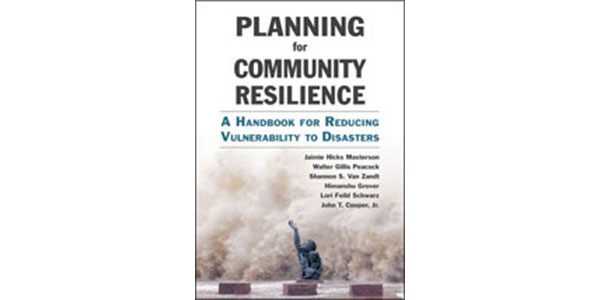
Authors: Jamie Hicks Masterson, Walter Gillis Peacock, Shannon S. Van Zandt, Himanshu Grover, Lori Feild Schwarz, John T. Cooper, Jr. (Island Press, 2014)
When we talk about sustainability and sustainable design, a lot of times we hear the term “mitigation”. The effects of a changing climate on our planet have caused us to start looking more intensely into forms of planning that will allow us to prepare for things unseen and protect ourselves against unforeseeable events. One area that has become heightened since our climate has begun to change is weather-related natural disasters (Hurricane Ike, Hurricane Sandy, numerous tornado outbreaks in the midwestern United States, drought leading to wildfires in California and British Columbia). Currently, the plans in place to deal with these disasters which are happening more frequently and viciously are not up to the standards that we need them to be, in order to come out the other side in a safe and manageable way. With this in mind, Planning for Community Resilience: A Handbook for Reducing Vulnerability to Disasters creates a very stringent and intense set of planning tools that professionals and community leaders can use to strengthen their resilience in the face of potential disasters.
The book is broken into three parts that progress logically through tiers of information. At the end of each chapter, readers are given an exercise – based on the information learned – that one could employ in classroom setting as a small project or discussion piece, or as a tool if you are a community leader that you could employ in a strategy session. They are informative and help to make sure the messages being delivered are being received correctly.
The first part – titled “Community Resilience” – defines resilience, how our world is changing with more disasters on the horizon, and how the basic “disaster phases” work. This part of the book is a quick read and really helps set the stage for the rest of the content.
The act of explicitly stating what term resilience means to them is an integral piece of information to have in order to understand their process. As such, the authors, pull from many different iterations of the meaning, and create their own: “resilience is the ability of a community and the biophysical systems upon which they depend, to resist or absorb the impacts (deaths, damage, losses, etc.) of natural hazards; rapidly recover from those impacts; and reduce future vulnerabilities through adaptive strategies.”
The book cites many sources throughout, but in terms of the general study behind the book, it revolves around Galveston, Texas and Hurricane Ike, where the team did all their primary research. While in some books this has hampered the ability to purvey other case-studies worldwide (or even nationwide), Planning for Community Resilience did a strong job of keeping the content of Galveston relevant. The authors were able to move fluidly out of the Texan context into other areas and hypotheticals, without losing their argument in the process.
The second part – “Knowing Your Community” – focuses on the next step to proper mitigation planning. It gives the reader tools to assess “Hazard Exposure…Physical Vulnerability…Social Vulnerability.” Each section has full chapters devoted to the latter, and without delving too deeply into each, it was very clear that each area was just as integral as the next.
Interestingly, while Hazard Exposure is something that has been looked at for a long time, Social Vulnerability seems to fall by the wayside quite a bit. The authors write, “In many communities, if not most, the social geography interacts with the physical geography to expose vulnerable populations to greater risk. Vulnerable populations are less likely to have access to both information and resources that would allow them to anticipate and respond to a real or perceived threat, yet they are more often than not the groups who most need to attend to warnings to evacuate or seek shelter.”
Given the above, the authors spent quite a bit of time referring back to Social Vulnerability given its often overlooked role. Needless to say, this may speak to much bigger issues beyond just planning.
The final part is titled, “Planning Strategies” and is the heaviest part of the book. Filled with facts and figures, it was very easy to get lost in the bar graphs and statistical data that had been mined. This isn’t to say it was bad or overwhelming. Seeing as how planning for situations like this could be one of the most in depth activities leaders would take part it, it would make sense that the data be thick, again helping to prove the argument of the plan the authors have laid out.
The third part also looks at current hazard mitigation plans (mostly rated by FEMA guidelines), and helps planners create a “toolbox”. It concludes on two chapters, one specifically related to the importance of consistency in planning, the other a general conclusion that sums up and narrows back in the focus of the book.
These chapters do a good job of bringing together the information cohesively. Again, while the book mainly takes place in Galveston, Texas this is quickly forgotten as the ideas supersede their location of origin.
In their conclusion, the authors make a refer to Dennis Milleti’s powerful quote: “disaster is a symptom of broad and basic problems of unsustainable growth and development.”
It is becoming more and more clear as our earth warms that natural disasters and “100 Year Storms” are becoming more frequent. Because of this, Planning for Community Resilience makes it abundantly clear that we must begin to add more focus on mitigation when planning for natural disasters and hazards. Socially and economically we will be better for it if we can implement the ideas brought forth in this great book. Ideas that speak to the fact that mitigation doesn’t have to be complicated and can be achieved with the proper planning steps.
***
For more information, visit the Island Press website.
**
Jeremy Senko is happily lost in the world of theoretical architecture and design. He is forever a student at heart, consistently reading, experiencing and learning about the world he inhabits. More specifically, he works as an Interior Designer in Vancouver and plays an active part in bettering the environments we live in.


